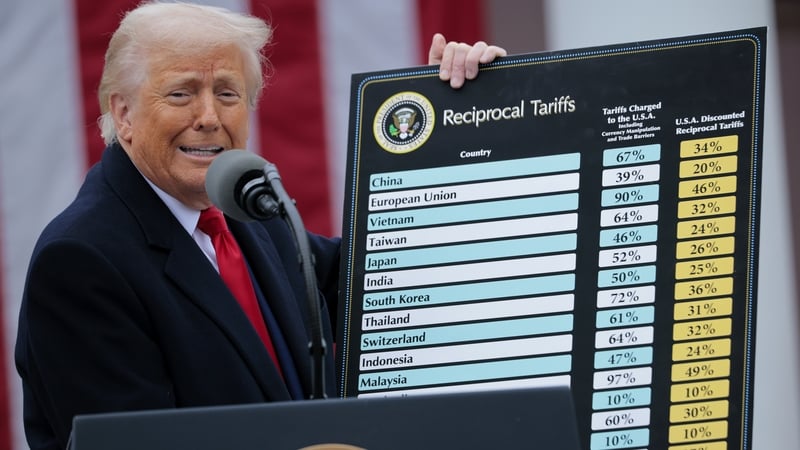We’ve seen this film before, it’s called Brexit.
It is not quite the Hollywood version because US President Donald Trump hates Hollywood.
However, it is bigger, louder, with more explosions and more gold leaf than the damp, tweedy, little-England original screenplay.
The moral of the story, however, is the same, be careful what you vote for.
The British voted to put up trade barriers against their biggest trading partner.
Everyone else said it was a bad idea that would leave the economy, and the government revenues that come from it, smaller than they could be.
Now the British economy is indeed smaller than it would have been if still a part of the EU, and the British government is locked into a doom loop of cutting spending and raising taxes to try and meet commitments that were affordable with the EU growth path, but which are just out of reach post-Brexit.

The Labour government is reaping the political whirlwind sown by the previous Conservative administrations, and the kind of Brexit they were politically boxed into by UKIP in its various guises.
A left-wing government having to make welfare cuts is an immediate disappointment to the voters who elected it.
But a major reset of economic arrangements is not easily changed once the course has been set.
Now a far bigger, far more important economy, indeed the most important, is undergoing a major reset of its economic arrangements.
And once again it is doing so on the back of a democratic mandate.
President Trump told the American people what he was going to do and why he was going to do it – and the people voted for it.
Tariffs were always part of the deal for the second Trump administration – build a trade wall and make the foreigners pay for it.

The people, especially the people in the seven swing states, had a choice, and they chose tariffs.
Do not be surprised if future retaliation from some of those foreigners is targeted at products made in those seven states.
And if this becomes a long drawn-out trade war, watch out for Republican senators running in anything close to a contested seat in the third of Senate seats that are up for election next year – export-oriented industries in any state that has a vaguely vulnerable Republican senator is now on the potential target list for retaliatory tariff measures.
Senators may become vulnerable, even though the 2026 list of seats up for grabs indicates no change to the current Republican ownership of the upper house.
Not from counter-tariffs, just from the malign effects anticipated to flow from the Trump tariffs unveiled in the White House Rose Garden on Wednesday evening.
In particular, the inflation and unemployment that most economists believe will flow from the tariff decision.
Stuff is going to get more expensive because the government is going to tax it and when things get more expensive, jobs tend to be trimmed to make the numbers fit.
As a result of the Executive Order signed on Wednesday, the world’s biggest economy raised the average tax rate it charges on imported goods from 2.5% to 22%. That is a big change.
Not only are Americans going to see prices rise: but they are already seeing the value of their pension savings fall.
The US stock markets dropped 5% each day on Thursday and Friday.
In the last half-century, according to Business channel CNBC, there have only been three other years in which there have been two consecutive days of 5% drops on the markets: 1987 (Stock market crash), 2001 (9/11) and 2008 (financial crisis).
That is the scale of shock-induced change we are talking about.

The numbers almost do not matter as they sound too fantastical for most of us to comprehend: $5 trillion in value wiped off shares (remember Elon Musk is trying to cut US government spending by $1 trillion).
Apple shares dropped some $300 billion in a single day, as investors repositioned themselves for what they think is coming.
By Friday evening, they were openly saying what they think is coming – a recession.
JP Morgan raised its assessment of a US recession this year to 60%, at the start of the year it was a 15% risk, same as any other normal year.
The currency is down as well, eroding one of the arguments of the pro-tariff Presidential advisers like Peter Navarro, that the dollar would appreciate, helping to offset the rise in purchase price for American consumers (the foreigners were supposed to “eat” the rest of the price rise to stay in the US market, with consumers only picking up a small part of the “adjustment”).
However, US investors are not buying this theory – hard hit in the selloff have been consumer-dependent stocks, especially those that rely on a lot of imported goods.
That chiefly means those that rely on China, the factory of the world.
Like supermarket chain Walmart or consumer electronics chain Best Buy or Apple, which gets its high-end (and high-margin) devices built mostly in Asia, particularly China.
Its been facing consumer headwinds already trying to convince folks to part with the guts of a grand to buy a new iPhone16. Imagine how much harder that task becomes with a 54% tariff on Chinese-made goods.
All of this saps the will of corporate boards to invest, and as investment is the lifeblood of an economy, any disruption to the flow of investment is bad news economically.
If you believe the Trump tariffs are here to stay, you will either invest in production capacity in the US or prepare to look elsewhere for growth opportunities to replace lost sales in your natural market (i.e. the one you are already doing business in successfully).
However, if you think President Trump will change his mind, which has been known to happen, then you might be inclined to not invest in your US operations to see which way the wind blows.
But the change in wind direction may take some time. In which case you are not investing in the US economy.
Again, we have seen this play out in Brexit, where lack of market access and uncertainty over the durability of the post-Brexit regime has caused firms to put off investment spending decisions.

An underperforming economy has been the result.
There is no shortage of warnings here that the US too could face economic difficulties as a result of this new tariff regime becoming permanent.
Not catastrophic damage, just a drag on the economy, a slow puncture – a measure of underperformance caused by less investment, less consumption, less growth, less employment.
With Brexit, the external response was coordinated by the remaining 27 member states of the EU, and was executed by their jointly-owned bureaucracy, the European Commission – one of the global powerhouses in trade negotiations.
In this American remake, another of the global powerhouses of trade negotiation is pitting itself against the rest of the world.
So the plot will play out differently. Some countries are in a very weak position with the US and will make almost any concessions to keep the US market (and the hard currency it provides) open.
Others, notably the EU and China, can go toe-to-toe in a bruising encounter that will damage all concerned.
Unlike Britain, the US actually does hold many of the cards in the global trading system.
Most importantly, it holds the dollar, the global trading currency.
It is also the pre-eminent source of digital services and is the world centre for Artificial Intelligence (AI), the powerfully disruptive new technology of our time.
Unlike Britain, the US cannot be boxed off and more or less forgotten about. It is far too big and powerful for that.
Its not like the EU and China can form a tag team to take America down: they are not natural allies – systemic rivals and economic competitors is how the European Commission sees China.
We are closer to Boston than Beijing.
A negotiated settlement is the best and only solution. But what does Trump actually want?
Close the trade gap? Sure, we can work on that.
We tried back in 2013, when the Trans-Atlantic Trade and Investment Partnership talks, better known as TTIP – kicked off in Dublin Castle.
The aim was the reduce non-tariff barriers in EU-US trade because tariff barriers were considered so small on most things that a formal free trade deal was not worth the effort.
So issues like hormone beef and chlorine chicken were on the table – as were technical “fixes” to satisfy both sides and open markets.
The talks ultimately went nowhere, the changing mood on both sides of the Atlantic starting to turn against anything that smacked of “Globalisation”.
But the technical work on non-tariff barriers presumably did not end up on a skip on its way to a landfill.
Presumably, all that can be dusted down and looked at again as potential solutions to ease trade flows between the EU and the US.
Buying more US energy products will also help.

It is easy enough to imagine a point is reached when a victory can be declared by the Americans and things go more or less back to normal.
That is the “rational shake-down” view of the tariffs.
However, what if he is serious about rebuilding US manufacturing (and the communities that used to depend on it), and wants to use tariffs as a protective measure to achieve that longer-term, harder-to-achieve goal?
That is a more ideological goal than closing a trade gap and sanding down the rough edges of existing trade frameworks.
As critics continue to blast the unorthodox, some say bogus, figures produced to decide each country’s new tariff rate by the US government, and the realities of the first part of the new regime start to bite on consignments of goods arriving in US ports from today, the ideological camp seems to be in the ascendant.
The other US-stated objective is to remake the global trading order, which the US is at the centre of.
Previous attempts to change the world trade regime have been difficult, drawn out, multilateral “rounds” involving pretty much every country on the planet that took years to achieve agreement.
If you want something done quickly, maybe throwing a big rock into the pond like Trump has done is the best way to get things moving fast.
An important early test case is tomorrow’s visit of Israeli Prime Minister Benjamin Netanyahu to Washington, here to make a case against the 17% tariff the US has stuck on one if its closest allies.
What makes the new US tariff regime so hard for foreigners to deal with is that it is driven by an ideological view backed up by a very loud and ruthless propaganda machine.
It does not look like a rational position, one that can be bargained with to arrive at a “sensible” solution.
In that respect, it is like Brexit, willing to accept damage to itself in order to make a point.
And that makes it very difficult to negotiate with, because there is no visible bottom line that can be delivered.




